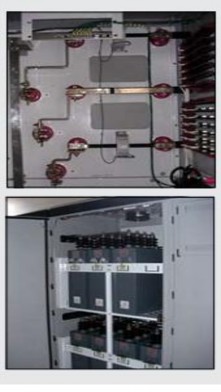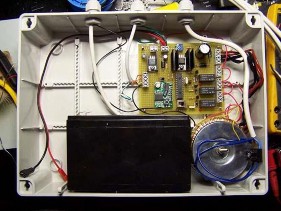

The photo at top left shows the power cable terminations, which are behind a locked panel. The power electronics are seen in the photo above, while some of the capacitors can be seen below left.
Passage 3: Install and check control panel on Home Security System
1. Survey your home and determine how many windows and doors you want to be “switched”, or integrated into the home security system.

Có thể bạn quan tâm!
-
 Tiếng Anh chuyên ngành Nghề Điện tử công nghiệp - CĐ Công nghiệp và Thương mại - 3
Tiếng Anh chuyên ngành Nghề Điện tử công nghiệp - CĐ Công nghiệp và Thương mại - 3 -
 Tiếng Anh chuyên ngành Nghề Điện tử công nghiệp - CĐ Công nghiệp và Thương mại - 4
Tiếng Anh chuyên ngành Nghề Điện tử công nghiệp - CĐ Công nghiệp và Thương mại - 4 -
 Tiếng Anh chuyên ngành Nghề Điện tử công nghiệp - CĐ Công nghiệp và Thương mại - 5
Tiếng Anh chuyên ngành Nghề Điện tử công nghiệp - CĐ Công nghiệp và Thương mại - 5 -
 Tiếng Anh chuyên ngành Nghề Điện tử công nghiệp - CĐ Công nghiệp và Thương mại - 7
Tiếng Anh chuyên ngành Nghề Điện tử công nghiệp - CĐ Công nghiệp và Thương mại - 7 -
 Tiếng Anh chuyên ngành Nghề Điện tử công nghiệp - CĐ Công nghiệp và Thương mại - 8
Tiếng Anh chuyên ngành Nghề Điện tử công nghiệp - CĐ Công nghiệp và Thương mại - 8 -
 Tiếng Anh chuyên ngành Nghề Điện tử công nghiệp - CĐ Công nghiệp và Thương mại - 9
Tiếng Anh chuyên ngành Nghề Điện tử công nghiệp - CĐ Công nghiệp và Thương mại - 9
Xem toàn bộ 134 trang tài liệu này.
2. Determine possible locations for the control panel and keypads. You might find it convenient to place a keypad close to the front door. You might also want a keypad close to the bedrooms. The control panel commands the system, and the keypads allow you to program the system and turn it, or its components, on and off.
3. Determine how far away windows and doors are from the control panel so that you know how far wires will be routed if you choose a wired alarm system or how far a wireless system needs to communicate with sensors. Keep in mind that it is difficult to install a hard-wired security system unless your house is still under construction.
4. Decide whether you want a monitored security system that will be monitored 24 hours a day. The central monitoring station ‘watches’ your home for a monthly fee. A less expensive alternative is a basic sensor system with a dialer accessory that connects the system to your phone lines and dials preselected numbers if the house’s security is breached.
5. Consider your lifestyle. Does anyone in the family often get up in the middle of the night for a snack? Do you have a large pet that roams the house at night? Such circumstances will influence the type of motion sensor you select and how it is installed. It may also call for you or members of your family to take trips to the keypad to prevent false alarms.
IV. EXERCISE
Mục tiêu: Kiểm tra kết quả đạt được của người học về sự hiểu biết các từ vựng chuyên môn cũng như ngữ pháp, kiến thức và kỹ năng đọc hiểu đã được học để hoàn thành các bài tập ứng dụng cũng như áp dụng vào trong môi trường làm thực tế sau khi tốt nghiệp.
1. Complete the sentences
knockouts screws cutter first bushings whether voice
a. The ……….. step is cut openings and install a low- voltage box at each outlet location.
b. One of the actions at the second step is to remove …………….. and fit the box with ……………. to protect the cables.
c. You have to check …………….the wires are positioned correctly before trimming any excess wire with a diagonal ……………….
d. At the fifth step, you use …………….. to fasten the module into place.
e. After snapping a telephone distribution panel into place, you attach a
………… and data module.
2. Answer the following questions
a. How many steps to install a low- voltage panel in your home?
.............................................................................................................................
.............................................................................................................................
b. Which step do you think is the most important?
.............................................................................................................................
.............................................................................................................................
c. When do you snap the Internet gateway into place?
.............................................................................................................................
d. What do you do at the ninth step?
.............................................................................................................................
.............................................................................................................................
e. Why do you need to test the system after finishing installation?
.................................................................................................................................
.................................................................................................................................
3. Decide True or False
a. Nunber 1 is used to refer to sockets for capacitive voltage detection system.
b. Number 4 is used to refer to manual operation for the mechanism of the load- break /disconnecting function.
c. Number 2 is used to refer to Indicator “Fuse intact / Fuse blown”
d. Number 16 is used to refer to switch position indicator for load-break and for grounding function "CLOSED-OPEN-GROUNDED"
e. Manual operation for the mechanism of the grounding function is Number 5.
4. Listen and Check
windows keypad sensors wires security program control panel construction how Survey your home and determine how many …………… and doors you want to be “switched”, or integrated into the home ………….. system.
Determine possible locations for the ……………… and keypads. You might find it convenient to place a ……….. close to the front door. You might also want a keypad close to the bedrooms. The control panel commands the system, and the keypads allow you to ……………….. the system and turn it, or its components, on and off.
Determine …………… far away windows and doors are from the control panel so that you know how far …………… will be routed if you choose a wired alarm system or how far a wireless system needs to communicate
with…………….. Keep in mind that it is difficult to install a hard-wired security system unless your house is still under …………..
5. Match the ideas
1. If there is no sound,
2. If the line is correct,
3. Attach type-F coaxial connectors
4. Remove a protective cap
5. Connect patch cords
V. CONVERSATION
a. the tester emits a high-pitched sound.
b. to each incoming coaxial line, using coaxial stripping and crimping tools.
c. check other lines until you find the connected line.
d. between these modules and the appropriate plug-in.
e. from one of the GFCI receptacles and plug in the Internet gateway transformer.
Mục tiêu: Hình thành kỹ năng giao tiếp cho người học để người học có tự tin giao tiếp trong môi trường làm việc.
Nina: Hi, Henry
Henry: Hi, Nina. How’s everything? Nina: Well. Thanks. How about you? Henry: Fine, Thanks.
Nina: Do you know how to install a low voltage panel?
Henry: Yes, I do. I usually do it for my home.
Nina: How many steps are there, Henry? I think it’s really good for my test next week.
Henry: Really? Do you need any more help, Nina?
Nina: Do you mind if I meet you tonight to talk about it? I want you to tell me clearly all the steps and I’ll take notes.
Henry: No, not at all. What time? Nina: How about 6.30 at Seven Club? Henry: That’s all right. See you tonight. Nina: See you.
Unit 4: Computers
Trong lĩnh vực lắp đặt điện, thiết bị chiếu sáng và điều khiển chiếu sáng chiếm vị trí thường được ứng dụng. Bài học này giúp cho người học có kiến thức và kỹ năng về anh ngữ để đọc hiểu được cách lắp đặt thiết bị điều khiển chiếu sáng đồng thời cung cấp cho người học vốn thuật ngữ tiếng Anh chuyên ngành để người học có thể sử dụng trong môi trường làm việc với doanh nghiệp nước ngoài và đọc các tài liệu tham khảo chuyên ngành điện bằng tiếng anh.
Mục tiêu của bài học:
Sau khi học xong bài học này, sinh viên có khả năng sử dụng kiến thức và kỹ năng anh ngữ:
- Đọc hiểu được các bước lắp đặt thiết bị chiếu sáng và kiểm tra thiết
bị điều khiển chiếu sáng
- Hiểu các từ vựng và phát âm chính xác các thuật ngữ chuyên ngành về thiết bị chiếu sáng và điều khiển chiếu sáng
- Sử dụng dạng bị động đúng trong ngữ cảnh.
- Tự tin giao tiếp trong môi trường doanh nghiệp
Nội dung của bài học:
I. VOCABULARY
Mục tiêu: Cung cấp cho người học các từ vựng bằng tiếng anh trong lĩnh vực lắp đặt các thiết bị chiếu sáng và điều khiển chiếu sáng để người học có thể đọc và hiểu được từ chuyên môn liên quan đến một số tài liệu trong lĩnh vực điện điện tử công nghiệp bằng tiếng Anh.
Remote control (n) Hardware control (n)
Switch (n) Lighting (n)
Communication (n) Keypad (n) Microprocessor (n) Interface (v) Command (n) Automated (adj) Integrate (v) Automatically (adv) As long as (conj) Incandescent (n) Fluorescent (n)
High-intensity (n)
: Điều khiển từ xa
: Điều khiển phần cứng
: Công tắc
: Chiếu sáng
: Truyền thông
: Bàn phím
: Bộ vi xử lý
: Giao diện
: Điều khiển
: Tự động
: Tích hợp
: Tự động
: Miễn sao
: Nóng sáng
: Huỳnh quang
: Cường độ cao
Sodium (n) Vary (v) Efficiency (n) Closure (n) Homeowner (n) Execute (v) Controller (n) Capability (n) Contact (n) Closet (n)
Handle (on/off) (v) Invariably (adv) Dimmable (adj) Fixture (n) Identically (adv) Touchscreen (n) Retrofitable (adj)
: Nat ri
: Khác nhau
: Hiệu suất
: Sai số kép
: Chủ nhà
: Thực hiện
: Bộ điều khiển
: Khả năng
: Tiếp xúc
: Tủ
: Vận hành
: Không đổi
: Mờ
: Bộ gá lắp
: Giống nhau
: Màn hình
: Xúc giác
Discharge (n) Low-pressure (n) Generator (n) Distribution
Communication (n) Deal (n) Equipment (n) Mechanical (n) Control (n) Structure (n) Transportation systems Application (n) Conception (n) Manually operated mechanism
Actuating mechanism Form (n)
Built-in (v) Tighten a screw (v) Operation (n)
Insulation resistance
Voltage (n) Lighting installation
Earth wire (n) Protective conductor Live (L) (adj) Neutral (adj)
Twin cable (n) Fittings (n) Terminal (n) Circuit diagram (n) Loop (n)
Gear (n) Pulley (n)
Center-to-center distance
: Phóng điện
: Áp suất thấp
: Máy phát điện
: Sự phân phối
: Truyền thông
: Gỗ thông
: Thiết bị
: Cơ khí
: Điều khiển
: Kết cấu
: Hệ thống truyền tải
: Sự ứng dụng
: Khái niệm
: Vận hành bằng tay
: Khởi động
: Hình dạng, mẫu
: Đưa vào
: Siết chặt đinh ốc
: Vận hành
: Điện trở cách
điện
: Điện áp
: Lắp đặt hệ thống chiếu sáng
: Dây nối đất
: Dây dẫn bảo vệ
: Có điện
: Trung tính
: Cáp xoắn đôi
: Đồ phụ tùng
: Đầu cực
: Sơ đồ mạch điện
: Mạch
: Bánh răng
: Cái ròng rọc
: Khoảng cách từ tâm đến tâm
Internal (adj) Relay (n) Active (adj) Effect (n) Least (adj) Contact (n) Test ( v) Triable ( adj) Testable ( adj) Insulate (v )
Insulating tape (n)
Closing ( n) Cut (v) Measure( n ) Joint ( n) Capacity (n) Check ( n ) Property ( adj)
Magnetization ( n ) Polarity ( n ) Regulation ( n) Adjust ( v) Adjustable( adj )
Series ( n) Put ( v)
Preparation ( n )
Prepare ( v) Equipment ( n) Material ( adj) Research ( n) Consecutive (adj)
Insulation tape (n) Junction box (n) Plywood (n) Lubrication (n)
: Bên trong
: Rơ le
: Tích cực
: Tác động
: Nhỏ nhất
: Tiếp xúc
: Kiểm tra
: Thử
: Kiểm tra được
: Cách điện
: Băng cách điện
: Đóng
: Cắt
: Đo lường
: Mối nối
: Điện dung
: Sự kiểm tra
: Đặc tính
: Từ hóa
: Cực tính
: Quy tắc
: Điều chỉnh
: Điều chỉnh
: Dãy
Đặt để
: Sự chuẩn bị
: Chuẩn bị
: Thiết bị
: Vật liệu
: Nghiên cứu
: Nối tiếp
: Băng cách điện
: Hộp nối
: Ván ép, gỗ dán
: Sự bôi trơn
: Đặc tính
: Giảm ma sát
: Cần trục
: Tời
Adjacent = near Adequate (adj)
: Gần, kế bên
: Đầy đủ
Specification (n)
Antifriction (n) Crane (n)
Hoist (n) Rack (n) Roller (n)
: Giá đỡ
: Con lăn
II. GRAMMAR
Mục tiêu: Cung cấp cho người học cấu trúc ngữ pháp về thì hiện tại đơn trong tiếng Anh để người học có thể sử dụng trong quá trình viết hoặc giao tiếp trong công việc tại nơi làm việc hoặc trong đồi sống hằng ngày có liên quan.
2.1 Passive voice of Simple Present Tense
*Affirmative
S + be + V (past participle) + O
Eg: It is called an insulated plier
Voltmeters are made in a wide range of styles
Electric equipment is used to install eletricity in businesses and homes with safety.
S + be + not + V (past participle) + O
* Negative
Eg: It isn’t called an insulated plier
Voltmeters aren’t made in a wide range of styles
* Yes / No question
Be + S + V (past participle) + O?
Yes, S+be No, S + be not
Eg: - Is it called an Amperemeter? Yes, it is / No, it isn’t.
- Is Electric equipment used to install eletricity in businesses and homes with safety?
Yes, it is / No, it isn’t .
2.2 Exercise
Rewrite the sentences in passive voice.
1. He opens the door. → ......................................................................................
2. We set the table. → ..........................................................................................
3. She pays a lot of money. → .............................................................................
4. I draw a picture. →...........................................................................................
5. They wear blue shoes. → .................................................................................
6. They don't help you. → ....................................................................................
7. He doesn't open the book. →............................................................................
8. You do not write the letter,→ ...........................................................................
9. Does your mum pick you up? → ......................................................................
10. Does the police officer catch the thief? → ......................................................
III. CONTENT
Mục tiêu: Hình thành kiến thức và kỹ đọc hiểu cho người học để người học có thể đọc được một số tài liệu liên quan đến lắp đặt thiết bị chiếu sáng và điều khiển chiếu sáng bằng tiếng Anh.
The central control design method uses remote or hardwires control switches to control all your lighting needs in the house. Data communication wiring from keypad is routed back to microprocessor to allow both type of user interfaces to communicate control commands. Automated lighting control can also be integrated into the home system to control lighting on and off automatically. When an individual enters a specific room in the home, the lighting serving the room will immediately be turned on and the light to continue to be on as long as you are in the room.
![]()
Light Types
There are four basic types of lighting: incandescent, fluorescent, high- intensity discharge, and low-pressure sodium. Incandescent lighting is the most common type of lighting used in homes. Fluorescent lighting is used primarily in commercial indoor lighting systems, while high-intensity discharge lighting is used only for outdoor lighting applications. Low-pressure sodium lighting is used where color rendering is not important, such as highway and security lighting. These lighting types vary widely in their construction, efficiency, color characteristics, and lamp life.
Switch closure - the homeowner presses a button on a keypad or switch
Time - scenes can be programmed to execute at a time of day
Sunrise/sunset - controllers can use an outside light level sensor or, if they have enough programming capability, can keep a table of local sunrise/sunset times for any date.
Contact closure - any contact closure such as a magnetic door sensor or other security sensor can be used to execute a scene. A magnetic sensor






